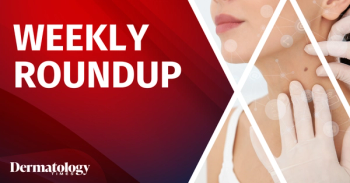
New Insights into Biologic Therapies for BP
Key Takeaways
- Dupilumab showed higher disease control and remission rates than omalizumab in BP patients, with faster response times and lower relapse rates.
- Both biologics were generally well-tolerated, but dupilumab had a significantly lower discontinuation rate compared to omalizumab.
Complete remission was achieved in over 87% of dupilumab users and 64% of omalizumab users.
Bullous pemphigoid (BP) is the most prevalent autoimmune blistering disease globally, primarily affecting the elderly population.1 While conventional therapies such as high-potency topical corticosteroids and systemic immunosuppressants remain the mainstay of treatment, their long-term use may be limited by contraindications or insufficient response, particularly in patients with complex comorbidities.2 Consequently, there has been increasing interest in the use of biologic agents like dupilumab and omalizumab, which have shown promise in smaller case reports but lack robust clinical validation in the context of BP.3
Study Methods
A recent multicenter, retrospective cohort study conducted across 15 Italian tertiary referral hospitals aimed to address the current evidence gap by analyzing real-world outcomes in patients with BP treated with either omalizumab or dupilumab between January 2017 and March 2023.4 The study included 58 adults diagnosed according to the European Academy of Dermatology and Venereology (EADV) criteria. Data were collected on clinical features, treatment regimens, disease activity, and adverse events, with a minimum follow-up period of 8 weeks.
Of the included patients, 39 received dupilumab (67.2%) and 19 were treated with omalizumab (32.8%). The majority in both cohorts had classic BP, and most patients received the biologics in combination with systemic or topical corticosteroids. Disease severity was assessed using the BP Disease Area Index (BPDAI), pruritus intensity with the peak pruritus numeric rating scale (PP-NRS), and quality of life with the Dermatology Life Quality Index (DLQI).
Key Findings
Efficacy
The study found that dupilumab achieved disease control in 90.6% of patients, with 56.2% reaching control within 8 weeks. Furthermore, 87.1% achieved complete remission, and relapse occurred in only 10.3% of cases. In contrast, omalizumab led to disease control in 77.8% of patients, with a significantly lower proportion (27.7%) reaching control within 8 weeks. Complete remission was observed in 64.7%, and relapse was more frequent (35.7%).
Time to Response and Remission
Patients treated with dupilumab experienced shorter mean times to disease control and complete remission compared to those on omalizumab. While these differences were not statistically significant, they may be clinically relevant, especially in managing refractory BP cases.
Safety and Discontinuation
Both biologics were generally well-tolerated. Dupilumab had a lower discontinuation rate (15.6%) compared to omalizumab (61.1%), with fewer patients stopping treatment due to lack of effectiveness or adverse events. Importantly, no severe drug-related complications were observed in either cohort.
Subgroup Analyses
In patients with immunotherapy- or gliptin-associated BP, dupilumab was found to be particularly effective, with all patients achieving disease control and the majority reaching complete remission without relapse. One gliptin-associated BP patient treated with omalizumab discontinued therapy due to lack of efficacy.
Discussion
While the findings suggest that dupilumab may offer superior clinical outcomes compared to omalizumab, especially in terms of speed of disease control, complete remission rates, and relapse prevention, researchers stated the absence of statistically significant differences limits definitive conclusions. Notably, patients in the omalizumab group had more severe baseline disease and higher cumulative steroid exposure, potentially confounding the comparisons.
Nonetheless, both dupilumab and omalizumab appear to be valuable therapeutic options in difficult-to-treat or corticosteroid-contraindicated BP, particularly in subtypes associated with medications like DPP-4 inhibitors or immune checkpoint inhibitors. The favorable safety profile and effectiveness of dupilumab in these challenging cases are particularly noteworthy.
Conclusion
This study contributes important real-world data supporting the utility of dupilumab and omalizumab as adjunctive therapies for BP, with dupilumab showing a trend toward more favorable outcomes. Further prospective, randomized trials are warranted to validate these findings and define optimal treatment algorithms for BP incorporating biologic agents.
References
- Daniel BS, Murrell DF. Review of autoimmune blistering diseases: the Pemphigoid diseases. J Eur Acad Dermatol Venereol. 2019;33(9):1685-1694. doi:10.1111/jdv.15679
- Borradori L, Van Beek N, Feliciani C, et al. Updated S2 K guidelines for the management of bullous pemphigoid initiated by the European Academy of Dermatology and Venereology (EADV). J EurAcad Dermatol Venereol. 2022;36(10):1689-1704. doi:10.1111/jdv.18220
- Velin M, Dugourd PM, Sanchez A, Bahadoran P, Montaudié H, Passeron T. Efficacy and safety of methotrexate, omalizumab and dupilumab for bullous pemphigoid in patients resistant or contraindicated to oral steroids. A monocentric real-life study. J Eur Acad Dermatol Venereol. 2022;36(7):e539-e542. doi:10.1111/jdv.17999
- Avallone G, Maronese CA, Zussino M, et al. Effectiveness of dupilumab and omalizumab in bullous pemphigoid: A nationwide retrospective cohort study. J Dermatol. Published online April 16, 2025. doi:10.1111/1346-8138.17742
Newsletter
Like what you’re reading? Subscribe to Dermatology Times for weekly updates on therapies, innovations, and real-world practice tips.


















